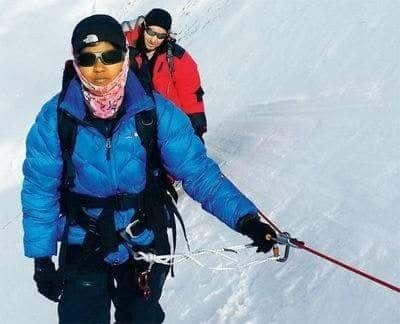Last Tuesday, I found myself sitting in a nearly empty movie theatre watching Poorna – a quiet, under-the-radar film that packed an emotional punch louder than any blockbuster. It didn’t have Bollywood’s usual star power or cinematic glamour, but it offered something far more lasting: a real-life leadership lesson that resonated deeply.
The movie chronicles the true story of Malavath Poorna – a 13-year-old tribal girl from Telangana who went on to become the youngest girl in the world to scale Mt. Everest. The odds stacked against her were enormous – poverty, social stigma, caste discrimination, and the crushing limitations society often places on girls from underprivileged backgrounds. And yet, she rose, quite literally, above it all.
What stood out to us wasn’t just the feat of climbing Everest. It was the leadership behind the ascent. IPS officer Dr. R. S. Praveen Kumar, a visionary educator, coach, and changemake, was the wind beneath her wings.
In our experience working with leaders and managers across corporate India, we’ve come to believe that the essence of good leadership isn’t in position or power. It lies in the ability to inspire, to enable growth in others, and to persist even when the destination seems unclear.
Through the lens of this extraordinary true story, here are three timeless leadership development lessons, especially relevant for L&D professionals, HR teams, and managers shaping the leaders of tomorrow.
Related Reading: Learnings from a movie: Captain Phillips

1. Find Your Own Voice
Table of Contents

“Main toh itni poor hoon ke mere toh naam mein hi ‘poor’ hai.”
(“We’re so poor that even my name has ‘poor’ in it.”) — a tongue-in-cheek line from the film that cuts deep.
When Dr. Praveen Kumar became an IPS officer, the obvious career trajectory would have been to climb bureaucratic ladders, take high-profile assignments, and perhaps even enter the political spotlight. But he chose a different path – one that many thought was too modest for someone of his caliber.
He decided to work at the grassroots level, focusing on transforming the lives of children from marginalized communities through education.
In our leadership development work, we’ve noticed that the most authentic and impactful leaders are the ones who follow their inner compass, even when external voices push them elsewhere.
New managers, especially, face this dilemma. They’re often encouraged to mimic someone else’s style or meet traditional expectations of what a “leader” should look like. But leadership is not a costume – it’s a craft. And it starts by being genuinely connected to one’s purpose and values.
L&D Takeaway:
Create space in your leadership programs for reflection. Encourage new leaders to explore:
- What do I stand for?
- What kind of leader do I want to become?
- What makes me restless, and why?
Helping people find their voice early on can prevent them from becoming copy-paste leaders later.
Related Reading: 10 Lessons from The Movie Mission Mangal
2. Create More Leaders, Not Followers

If there’s one enduring legacy a great leader leaves behind, it is this: more leaders.
Dr. Praveen Kumar didn’t just help Poorna climb a mountain – he sparked a revolution. His approach wasn’t about producing a handful of success stories; it was about challenging the entire narrative that said certain kids from certain backgrounds don’t belong in places of achievement.
Through his educational reforms and mentorship, he nurtured leadership qualities in hundreds of young people. He introduced the famous “10 Commandments” for students – a value-based manifesto that included powerful affirmations like:
- “I am not inferior to anyone”
- “I shall be the leader wherever I am”
- “I shall never give up”
In our experience, this principle aligns beautifully with what we aim to achieve in leadership journeys: self-belief, responsibility, and resilience.
We’ve seen first-time managers flourish when given the chance to uplift others – when they move from “doing the work” to enabling the work. The shift from being the hero to creating heroes is not just noble – it’s necessary in today’s fast-changing business environment.
L&D Takeaway:
Design leadership programs that go beyond role-readiness. Include:
- Mentorship modules where new managers mentor interns or junior staff
- Coaching skills as a part of the curriculum
- Group challenges that require collective decision-making and leadership rotation
We’ve noticed that when managers learn to develop others, they also grow more confident in their own leadership.
Related Reading: Blended Learning Journeys: Making Learning Stick for Lasting Impact
3. Just Show Up

“It’s not the mountain we conquer, but ourselves.” – Edmund Hillary
Neither Poorna nor Dr. Praveen had a crystal-clear roadmap when they began. There were no guarantees. But they showed up, every day, with discipline, belief, and courage.
In our work with new managers, we often hear anxieties like:
- “What if I fail?”
- “I don’t know how to deal with conflict.”
- “I’m not sure how to give feedback.”
These are valid fears. Leadership is messy, uncertain, and often uncomfortable. But the act of showing up, of being present with your team, of admitting when you don’t have all the answers – that’s where trust is built.
We’ve seen that the best leaders aren’t the ones who always succeed. They’re the ones who keep showing up, especially when it’s hard.
Poorna’s journey to Everest wasn’t just physical – it was symbolic of how consistent, small steps in the right direction can transform lives.
L&D Takeaway:
Help managers embrace vulnerability and persistence:
- Include stories of failure in training (real ones, not polished versions)
- Normalize asking for help
- Reinforce the idea that leadership is a journey, not a destination
The impact of this kind of mindset shift is significant – teams become more resilient, and leaders become more human.
Related Reading: 20 Lessons From The Movie Dangal
Reflection: What Poorna’s Story Teaches Corporate Leaders
As we reflected on Poorna’s journey from our lens as facilitators and learning consultants, here’s what stood out:
🔹 Leadership isn’t positional – it’s intentional.
Praveen wasn’t in a traditional L&D role. Yet he became one of the most effective leadership developers we’ve seen – because he saw potential where others saw limits.
🔹 Equity and inclusion aren’t just buzzwords.
They’re principles that change lives. Poorna’s success shows what’s possible when access, belief, and opportunity align.
🔹 Purpose powers performance.
Whether it’s a school in rural India or a corporate boardroom, purpose-driven leadership inspires action, attracts loyalty, and builds legacies.
Bonus Lesson: Leadership at the Margins Teaches Us What Corporates Often Forget
In our corporate training journeys, we often work with high-potential managers from fast-growing companies. While they bring energy and competence, we sometimes notice a disconnect from deeper purpose.
Stories like Poorna’s remind us – and the leaders we work with – that leadership is not about status. It’s about service. It’s not about being the loudest voice in the room, but about amplifying voices that are never heard.
In our corporate training journeys, we often work with high-potential managers from fast-growing companies. While they bring energy and competence, we sometimes notice a disconnect from deeper purpose.
Stories like Poorna’s remind us – and the leaders we work with – that leadership is not about status. It’s about service. It’s not about being the loudest voice in the room, but about amplifying voices that are never heard.
This is a lesson not found in PowerPoint decks, but in lived experience.
Related Reading: 25 Inspirational Movies For Teams
What Can L&D Professionals Do Differently?
If you’re in a role where you shape the leadership culture of your organization, here’s what we’ve found helpful:
- Make space for real stories. Not just case studies from Fortune 500s but everyday heroes who show grit and grace.
- Create leadership journeys that blend head and heart – competencies and character.
- Equip leaders to grow others, not just themselves.
- Teach them that presence, not perfection, is what builds credibility.
Related Reading: 8 Bollywood Movies That Inspire Leadership
Final Word: What Will You Choose to Climb?
Not all of us will climb Everest. But all of us face mountains – invisible or otherwise.
As professionals in the space of leadership and development, we hold the ropes for others. We influence the systems, design the experiences, and create the scaffolding for growth.
What Poorna and Dr. Praveen Kumar’s story tells us is this: one empowered leader can change a generation.
What will you choose to do with your leadership today?
Let’s keep the conversation going.
What’s your biggest takeaway from this story? How are you enabling leaders within your organization to find their voice, build others up, and show up consistently?
We’d love to hear from you.










